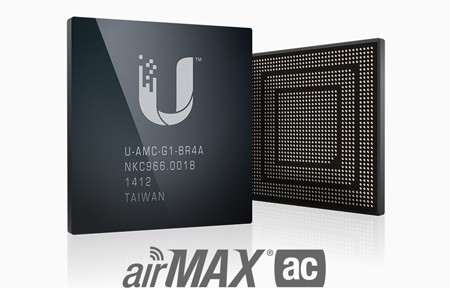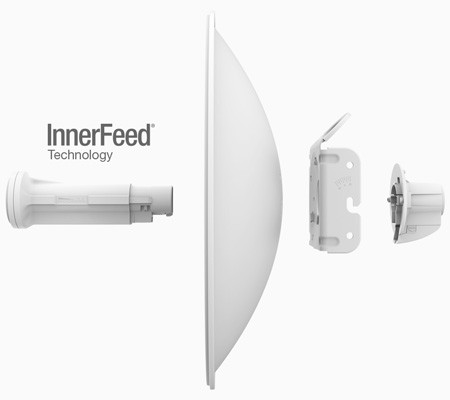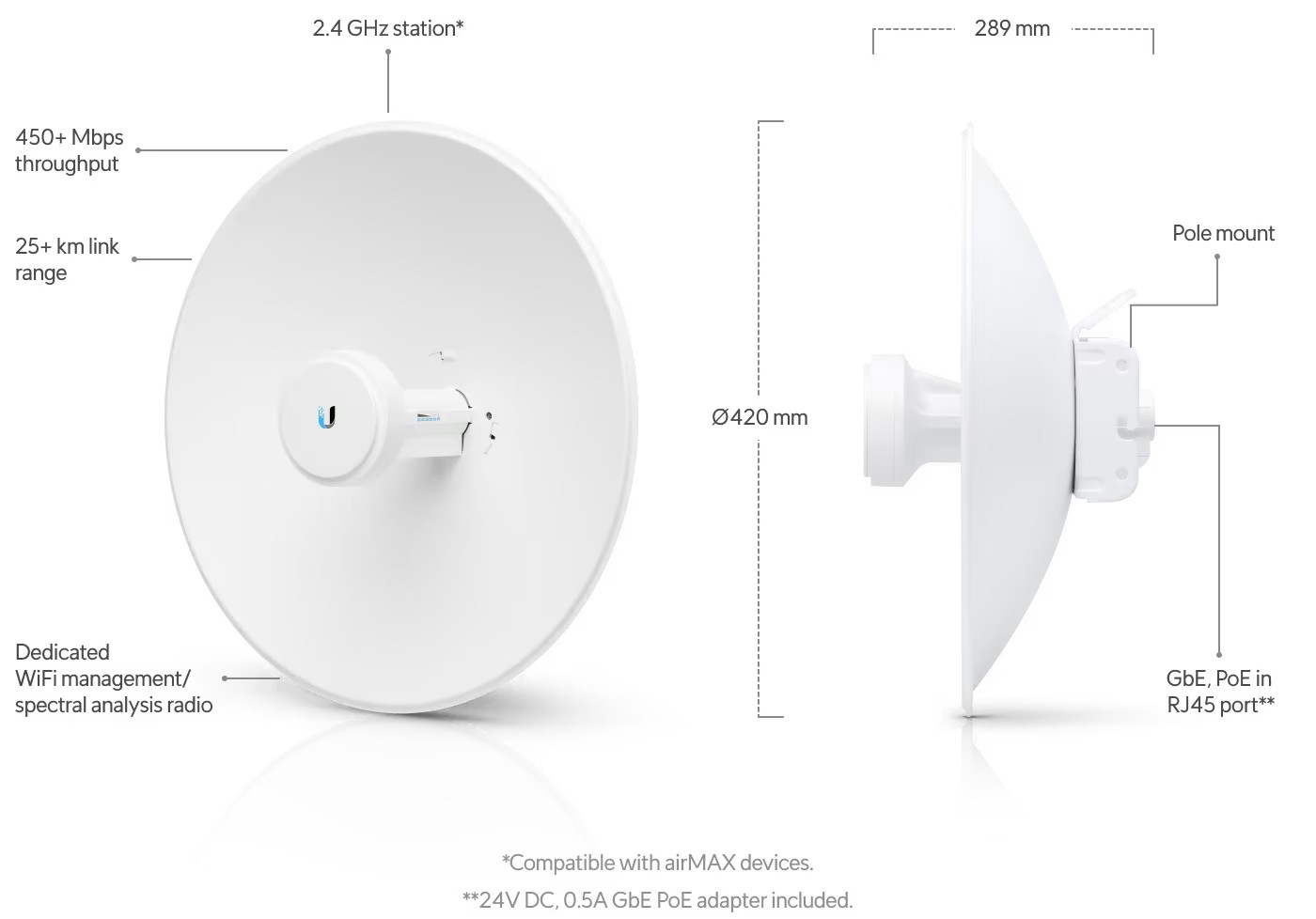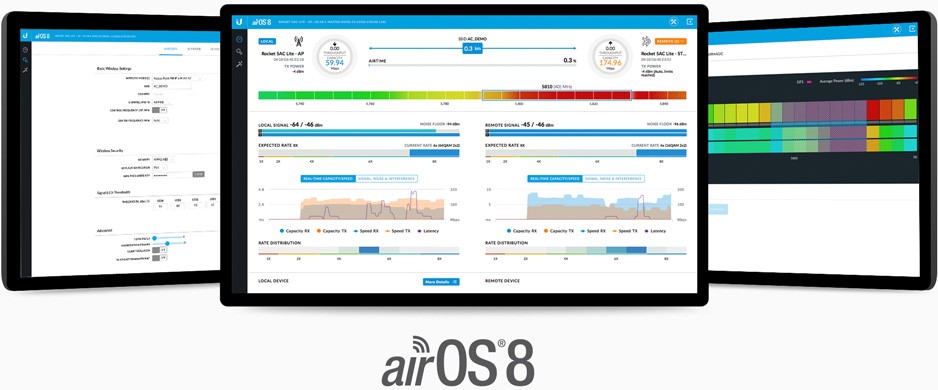2.4 GHz WiFi antenna with a 450+ Mbps Real TCP/IP throughput rate and 25+ km link range.
The airMAX PowerBeam 2AC 400 is a robust, high-performance wireless networking device developed by Ubiquiti Networks. This device is specifically designed to provide reliable, high-speed wireless broadband connectivity over long distances, utilizing Ubiquiti's advanced airMAX ac technology. It operates within the 2.4 GHz frequency band, making it well-suited for a wide range of outdoor wireless applications, including point-to-point (PtP) links and point-to-multipoint (PtMP) networks.

The PowerBeam 2AC 400 is designed to work in harmony with other devices in the airMAX series, especially those that support the airMAX ac protocol and operates in the 2.4 GHz frequency band. This compatibility ensures efficient and high-capacity wireless connections for both point-to-point (PtP) and point-to-multipoint (PtMP) configurations, making it an ideal solution for expanding or integrating into existing airMAX networks. Also, keep in mind that it does not natively integrate with the UniFi series, which is managed through the UniFi Controller software. The UniFi series targets managed Wi-Fi networking within indoor and semi-outdoor environments and operates on a different platform from airMAX devices.
Central to the PowerBeam 2AC 400's design is its integrated directional antenna with a 400 mm reflector dish and gain of 18 dBi , which significantly enhances signal gain and directivity. This design focus allows the device to concentrate its signal for targeted delivery over 25+ km, effectively minimizing interference and ensuring optimal performance even in environments with high RF noise levels. The result is a highly efficient, long-range wireless link capable of delivering substantial throughput rates, essential for applications requiring robust and reliable data transmission.

The PowerBeam 2AC 400 incorporates Ubiquiti's proprietary airMAX ac technology, which utilizes a Time Division Multiple Access (TDMA) protocol to improve scalability and reduce latency in wireless networks. This technology enables more efficient bandwidth utilization, allowing for higher data rates and improved network performance. The device also supports Ubiquiti's Intelligent QoS (Quality of Service) features, which prioritize traffic to ensure that critical data, such as voice and video communications, are transmitted seamlessly, enhancing the overall quality of the network connection.

One of the key attributes of the PowerBeam 2AC 400 is its versatility and ease of deployment. Ubiquiti’s InnerFeed® technology integrates the radio into the feedhorn of an antenna, so there is no need for cables to connect the radio to the antenna. This improves performance because it eliminates cable losses. The PowerBeam® AC requires no tools for assembly; only a single wrench is required for pole-mounting. Also, the device comes equipped with a mounting bracket and hardware, facilitating straightforward installation on poles or masts. Its design incorporates features to simplify alignment and positioning during setup, ensuring that optimal signal alignment can be achieved with minimal effort, which is critical for maximizing link stability and throughput.
Durability is another cornerstone of the PowerBeam 2AC 400's design. Built from is made from die-cast UV-stabilized plastic to withstand the challenges of outdoor deployment, the device features a rugged, weather-resistant housing that protects its internal components from harsh environmental conditions, including rain, wind, and extreme temperatures from -40 °C to 70 °C. This ensures long-term, dependable operation in a variety of climatic conditions, making it an ideal choice for outdoor wireless networking applications across diverse geographic locations.
Security features are integral to the PowerBeam 2AC 400, with WPA2 encryption standards ensuring secure wireless communication. This protects the network against unauthorized access and data breaches, maintaining the integrity and confidentiality of transmitted information.
The PowerBeam 2AC 400 is managed using Ubiquiti's airOS, a sophisticated, intuitive web-based interface that provides comprehensive tools for configuring, managing, and monitoring the device. airOS offers a wide range of features, including advanced RF analytics, real-time status reporting, and device management capabilities, allowing network operators to finely tune their wireless networks for optimal performance.
Choosing the right PowerBeam
Selecting the right PowerBeam product from Ubiquiti for your network involves a nuanced understanding of your specific needs and environmental conditions. Consider the frequency band: 2.4 GHz models like the PBE-2AC-400 and PBE-M2-400 are adept at penetrating obstacles and are suitable for medium-range deployments, while 5 GHz models, including PBE-5AC-Gen2, PBE-5AC-500, PBE-5AC-620, and PBE-5AC-ISO-Gen2, offer higher throughput and are ideal for clearer, longer-range links. The choice between these depends on the balance between range, throughput, and environmental factors such as different urban / natural obstacles and interference.
Antenna size directly influences range and signal focus: larger dishes on the PBE-5AC-500 and PBE-5AC-620 support the longest distances, whereas the PBE-5AC-Gen2 provides versatile deployment options. The PBE-5AC-ISO-Gen2's enhanced noise isolation makes it perfect for high-interference environments. Lastly, deployment scenarios—whether seeking broad coverage for multiple locations or a focused beam for direct point-to-point links—will guide your selection. Budget considerations and future scalability also play crucial roles in determining the most cost-effective and performance-optimized choice for your wireless network infrastructure
Compare with similar products
| | | | | | |
|---|
| Wireless Standard | |
| |
| 802.11ac
| 802.11ac
| 802.11ac
| 802.11ac
| 802.11ac
|
| 2.4GHz Radio Rate | |
| |
| 450 Mbps
|
|
| 450 Mbps
| 450 Mbps
|
| 5GHz Radio Rate | |
| |
| 450 Mbps
| 450 Mbps
|
|
|
| Wireless Antenna Frequency Range & Gain | |
| |
| 2.412 - 2.472 (GHz) 18 (dBi)
| 5.150 - 5.875 (GHz) 25 (dBi)
| 5.150 - 5.875 (GHz) 25 (dBi)
| 5.150 - 5.875 (GHz) 27 (dBi)
| 5.150 - 5.875 (GHz) 29 (dBi)
|
| Antenna range | |
| |
| 25 km
| 15 km
| 15 km
| 25 km
| 25 km
|
| Ethernet Ports | |
| |
| 1 x 1 Gbps
| 1 x 1 Gbps
| 1 x 1 Gbps
| 1 x 1 Gbps
| 1 x 1 Gbps
|
| Chipset | |
| |
| MIPS 74Kc
| MIPS 74Kc
| MIPS 74Kc
| Atheros MIPS 74Kc, 720 MHz
| Atheros MIPS 74Kc, 720 MHz
|
| RAM | |
| |
| 64 MB
| 64 MB
| 64 MB
| 128 MB
| 128 MB
|
| Storage Memory | |
| |
|
|
| 16 MB
| 16 MB
|
| Max Power Consumption | |
| |
| 7.5 W
| 8.5 W
| 8.5 W
| 8.5 W
| 8.5 W
|
| Weight | |
| |
| 1.795 kg
| 3.22 kg
| 2.22 kg
| 3.15 kg
| 6.4 kg
|
| | | | | | |
|---|
| Wireless Standard | 802.11ac
| 802.11ac
| 802.11ac
| 802.11ac
| 802.11ac
|
| 2.4GHz Radio Rate | 450 Mbps
|
|
| 450 Mbps
| 450 Mbps
|
| 5GHz Radio Rate |
| 450 Mbps
| 450 Mbps
|
|
|
| Wireless Antenna Frequency Range & Gain | 2.412 - 2.472 (GHz) 18 (dBi)
| 5.150 - 5.875 (GHz) 25 (dBi)
| 5.150 - 5.875 (GHz) 25 (dBi)
| 5.150 - 5.875 (GHz) 27 (dBi)
| 5.150 - 5.875 (GHz) 29 (dBi)
|
| Antenna range | 25 km
| 15 km
| 15 km
| 25 km
| 25 km
|
| Ethernet Ports | 1 x 1 Gbps
| 1 x 1 Gbps
| 1 x 1 Gbps
| 1 x 1 Gbps
| 1 x 1 Gbps
|
| Chipset | MIPS 74Kc
| MIPS 74Kc
| MIPS 74Kc
| Atheros MIPS 74Kc, 720 MHz
| Atheros MIPS 74Kc, 720 MHz
|
| RAM | 64 MB
| 64 MB
| 64 MB
| 128 MB
| 128 MB
|
| Storage Memory |
|
|
| 16 MB
| 16 MB
|
| Max Power Consumption | 7.5 W
| 8.5 W
| 8.5 W
| 8.5 W
| 8.5 W
|
| Weight | 1.795 kg
| 3.22 kg
| 2.22 kg
| 3.15 kg
| 6.4 kg
|
Technical Specs / Datasheet




Reviews and ratings
Product rating